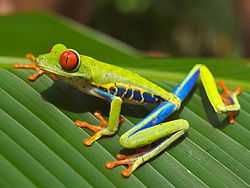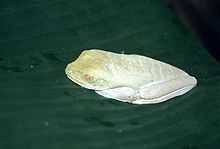Agalychnis callidryas
- For another species commonly known as the red-eyed tree frog, see Litoria chloris
| Red-eyed tree frog | |
|---|---|
 | |
| Conservation status | |
| Scientific classification | |
| Kingdom: | Animalia |
| Phylum: | Chordata |
| Class: | Amphibia |
| Order: | Anura |
| Family: | Hylidae |
| Genus: | Agalychnis |
| Species: | A. callidryas |
| Binomial name | |
| Agalychnis callidryas (Cope, 1862) | |
The red-eyed tree frog (Agalychnis callidryas) is an arboreal hylid native to Neotropical rainforests where it ranges from Mexico, through Central America, to Colombia.[1] It is sometimes kept in captivity.
As its name suggests, the red-eyed tree frog has red eyes with vertically narrowed pupils. It has a vibrant green body with yellow and blue vertically striped sides. Its webbed feet and toes are orange or red. The skin on the red-eyed tree frog's stomach is soft and fragile skin, whereas the back is thicker and rougher.
The red-eyed tree frog has three eyelids, and sticky pads on its toes. Phyllomedusine tree frogs are arboreal animals, meaning they spend a majority of their lives in trees; they are excellent jumpers.

Red-eyed tree frogs are not poisonous and rely on camouflage to protect themselves. During the day, they remain motionless, cover their blue sides with their back legs, tuck their bright feet under their stomachs, and shut their red eyes. Thus, they appear almost completely green, and well hidden among the foliage.
Diet
Red-eyed tree frogs are insectivores that eat crickets, moths, flies, and other insects.
Threats
The following have been listed as threats to the survival of the species on the IUCN Red List:[1]
- Residential and commercial development
- Housing and urban areas
- Agriculture and aquaculture
- Annual and perennial nontimber crops
- Shifting agriculture
- Small-holder farming
- Agroindustrial farming
- Livestock farming and ranching
- Small-holder grazing, ranching or farming
- Agroindustrial grazing, ranching or farming
- Annual and perennial nontimber crops
- Biological resource use
- Logging and wood harvesting
- Pollution
- Agricultural and forestry effluents
Reproduction
.jpg)
During mating season, the male frogs shake the branches where they are sitting to improve their chances of finding a mate by keeping rivals at bay. This is the first evidence that tree-dwelling vertebrates use vibration to communicate.[2] When rainfall is at its highest, a male red-eyed tree frog calls "chack" to get the attention of the female. During amplexis, the female carries the male on her back for up to several hours during the oviposition process. The female chooses a leaf above a pond or large puddle, on which to lay her clutch of eggs. The eggs develop into small tadpoles, which hatch after six to seven days and fall into the water below.[3] Red-eyed tree frog eggs exhibit phenotypic plasticity and will hatch earlier if a change in the environment, such as a predator or environmental change signals a danger to their survival.[4] Dragonflies, fish, and water beetles prey on the tadpoles. The tadpoles remain in the water from three weeks to several months, until they metamorphose into frogs. Snakes, spiders, bats, and birds of the rainforest prey on this frog. The young frogs that survive the first few weeks after metamorphosis move into the undergrowth and security of plants near their natal pools, often into the hollows of tubular plants such as bromeliads. Young frogs prey on very small flies and other insects during the first months of their lives. The young mature after two years and begin mating at the age of 3–4 years. These tree frogs are known to live up to five years (data from captive breeding programs), depending on the health and conditions of their habitat (i.e. abundant plant growth, plenty of fresh water, and an abundance of small and larger insects on which to prey).
They sometimes breed successfully in captivity if kept under adequate conditions in high-humidity vivaria (e.g. by using misting equipment), tropical plants such as Bromelia and other epiphyte plants, together with well-aerated water pools. Their captive habitat should have a light cycle with 11–12 hours of daylight and an average day temperature of 26–28 °C (and night-time averages of 22–35 °C). Simulating a rainy season once a year in November/December will encourage reproduction.
Distribution and habitat
Red-eyed tree frogs inhabit areas near rivers and ponds in rainforests from southern Mexico, through Central America, to northern Colombia.
See also
- Litoria chloris — the Australian red-eyed tree frog
References
- ↑ 1.0 1.1 1.2 Frank Solís, Roberto Ibáñez, Georgina Santos-Barrera, Karl-Heinz Jungfer, Juan Manuel Renjifo & Federico Bolaños (2008). "Agalychnis callidryas". IUCN Red List of Threatened Species. Version 2013.1. International Union for Conservation of Nature. Retrieved October 7, 2013.
- ↑ Caldwell, Michael S.; Johnston, Gregory R.; McDaniel, J. Gregory; Warkentin, Karen M. "Vibrational Signaling in the Agonistic Interactions of Red-Eyed Treefrogs". Current Biology 20 (11): 1012–1017. doi:10.1016/j.cub.2010.03.069.
- ↑ William F. Pyburn (1970). "Breeding behavior of the leaf-frogs Phyllomedusa callidryas and Phyllomedusa dacnicolor in Mexico". Copeia 1970 (2): 209–218. JSTOR 1441643.
- ↑ Fields, Helen. (2013 January). The frog that roared. Smithsonian, 54–61.
External links
| Wikispecies has information related to: Agalychnis callidryas |
| Wikimedia Commons has media related to Agalychnis callidryas. |
- Red-Eyed Tree Frog Facts
- Honolulu Zoo: Red-eyed Tree Frog
- Caring for Your Red-Eyed Tree Frogs
- Red-Eyed Tree Frog Care Information at Caresheets.net
- Red Eyed Tree Frog Care at RedEyedTreeFrog.org
- Article Road: List of All Frog Breeds: Things You Can Do to Ensure Your Frog Has a Long, Happy and Healthy Life: Red Eyed Tree Frog
- Aqualand: Keeping Your Red-Eyed Tree Frogs
- Red Eyed Tree Frogs as pets
